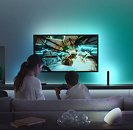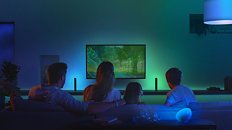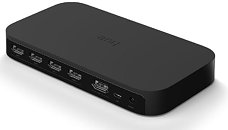Friday, September 20th 2019

Philips Announces the Hue Play HDMI Sync Box
Signify, a Philips partner, launches the Hue Play HDMI Sync Box. With this product, you can synchronize all your Philips Hue lamps with your television. The sync box is placed between an HDMI device and your TV.
For this purpose, the box receives the signal from up to four HDMI devices, analyzes the image content and then forwards the signal to the TV set. While the image signal is passed unchanged, the sync box passes the color values to the Philips Hue bulbs. Similar to Philips TV sets with "Ambilight", the TV picture is then synced to the smart Philips Hue lights. The lighting effects can be reproduced on up to 10 lamps/lights in an entertainment area. The more lights are involved, the more impressive the effect will be. The Sync Box supports satellite receivers and Blu-ray players as well as game consoles, notebooks or streaming devices.
Your color capable Philips Hue lights make explosions come alive, add magic to your favorite fairy tales and sync lights to music, all through the new Philips Hue Play HDMI Sync Box. Plug in your product and open the dedicated Philips Hue Sync mobile app to add this essential device to your Hue ecosystem for an amazing entertainment experience. Personalize settings via the app, and see how your Philips Hue lights come to life and match whatever you're watching, playing or listening to. With the ability to connect with as many as ten Philips Hue color capable lights, Philips Hue turns your living room in a cinema.
Home cinema in a flash
Light has long been used to enhance our entertainment experiences at concerts and the cinema. Until now, it's been difficult to create the same effects at home. However, you can now enjoy similarly visually immersive experiences from the comfort of your couch. Simply connect up to four HDMI devices to the Philips Hue Play HDMI Play Sync Box and watch your lighting come to life. Philips Hue lights will sync whatever content is being played on your HDMI devices, and creates an exciting and interactive experience in your whole room increasing the overall enjoyment of what is happening on the screen. The Philips Hue Play HDMI Play Sync Box is able to switch automatically between the four different HDMI channels, depending on which one is being used at that moment. No delays or lag - just plug in and the experience begins!
The Philips Hue Play HDMI Sync Box has its own dedicated app, to make sure you can control the light experience in a quick way. With the app you are able to finetune brightness, as well as the speed and intensity of the light effects. You can automate your device even more by configuring the default settings, making it even easier to use on an everyday basis with your entertainment system. In addition to enhancing your home entertainment experience, use your Philips Hue color-capable lights to access the full functionality the Hue ecosystem offers, including away-from-home control and ambiance creation.
The Philips Hue Play HDMI Sync Box is available for €249.95 incl. VAT / $229.99 from October 15 onwards. Availability will be at selected retailer and meethue.com in the US, Germany, Austria, Switzerland, Belgium, Luxembourg and Netherlands, Denmark, Sweden, Norway and Finland. Pre-sale starts now! More countries will follow early next year.
For this purpose, the box receives the signal from up to four HDMI devices, analyzes the image content and then forwards the signal to the TV set. While the image signal is passed unchanged, the sync box passes the color values to the Philips Hue bulbs. Similar to Philips TV sets with "Ambilight", the TV picture is then synced to the smart Philips Hue lights. The lighting effects can be reproduced on up to 10 lamps/lights in an entertainment area. The more lights are involved, the more impressive the effect will be. The Sync Box supports satellite receivers and Blu-ray players as well as game consoles, notebooks or streaming devices.
Your color capable Philips Hue lights make explosions come alive, add magic to your favorite fairy tales and sync lights to music, all through the new Philips Hue Play HDMI Sync Box. Plug in your product and open the dedicated Philips Hue Sync mobile app to add this essential device to your Hue ecosystem for an amazing entertainment experience. Personalize settings via the app, and see how your Philips Hue lights come to life and match whatever you're watching, playing or listening to. With the ability to connect with as many as ten Philips Hue color capable lights, Philips Hue turns your living room in a cinema.
Home cinema in a flash
Light has long been used to enhance our entertainment experiences at concerts and the cinema. Until now, it's been difficult to create the same effects at home. However, you can now enjoy similarly visually immersive experiences from the comfort of your couch. Simply connect up to four HDMI devices to the Philips Hue Play HDMI Play Sync Box and watch your lighting come to life. Philips Hue lights will sync whatever content is being played on your HDMI devices, and creates an exciting and interactive experience in your whole room increasing the overall enjoyment of what is happening on the screen. The Philips Hue Play HDMI Play Sync Box is able to switch automatically between the four different HDMI channels, depending on which one is being used at that moment. No delays or lag - just plug in and the experience begins!
The Philips Hue Play HDMI Sync Box has its own dedicated app, to make sure you can control the light experience in a quick way. With the app you are able to finetune brightness, as well as the speed and intensity of the light effects. You can automate your device even more by configuring the default settings, making it even easier to use on an everyday basis with your entertainment system. In addition to enhancing your home entertainment experience, use your Philips Hue color-capable lights to access the full functionality the Hue ecosystem offers, including away-from-home control and ambiance creation.
The Philips Hue Play HDMI Sync Box is available for €249.95 incl. VAT / $229.99 from October 15 onwards. Availability will be at selected retailer and meethue.com in the US, Germany, Austria, Switzerland, Belgium, Luxembourg and Netherlands, Denmark, Sweden, Norway and Finland. Pre-sale starts now! More countries will follow early next year.




17 Comments on Philips Announces the Hue Play HDMI Sync Box
Lag is also a valid point. If it only sniffs video, it delays it, while audio should be passed through faster, hence lip sync issue.
I'm also curious how ARC works and is it taken into account in this box. I surely hope so.
Ambilight devices ..
Technology o_O
www.instructables.com/id/Make-your-own-TV-ambilight-using-Arduino/
I really like it. Only thing that sucks are 21:9 content for films. The black bar kinda spoils the fun.
Also, the lack of mention of the HDMI variant used in this is a bit worrisome. If not 2.1 this will be DOA for enthusiasts.
I would like to do more aggressive experiment tho. I would mirror screen to chromecast, the added latency is no issue for hue lightening. Then the resolution is also whatever... it can be re sampled much lower... pretty much a workaround.
For starters it is A PC that is merely connected to LEDs via Arduino board.
Secondly, it is only capable of processing video output of the PC.
All that is crappy in many ways.
Whereas with this pricey Phillips device, you can pipe anything that has an HDMI output through it. (A console, HDMI andorid device, and what not).
Price is at least two times higher than what I'd found somewhat reasonable. But, uh, no, you can't do that with ANY open source project on the market, for starters, you won't get hardware with HDMI input.